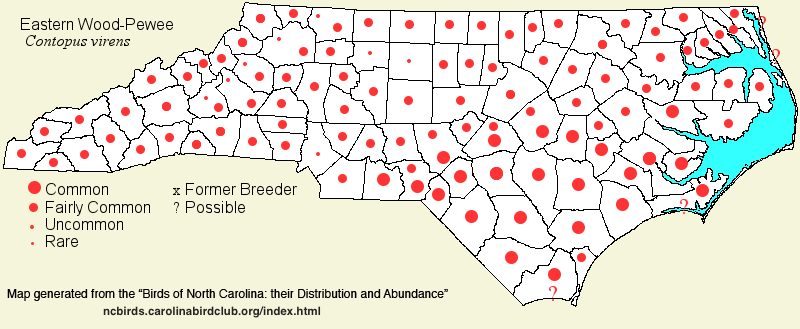 |  |
|
Eastern Wood-Pewee - Contopus virens TYRANNIDAE Members: | Search Common: Search Scientific: |
|
|
|||||||
| General Comments | The Eastern Wood-Pewee nests across the eastern half of the United States, but it completely clears out of the country by late fall. In the state, it nests in all 100 counties, though it is absent as a breeder on many or most coastal islands. Also, the species has declined somewhat in recent decades, perhaps in part owing to some loss of wintering habitat in the tropics. The species is still numerous in the state, nesting in open to medium-growth forests and woodlands, mostly in dry to mesic situations -- both in hardwoods and in pines. Favored habitats are open Longleaf Pine forests, but they even nest sparingly in wooded residential areas. They avoid higher elevations (mostly above 5,000 feet). A few pewees have been reported on CBC's over the years, but always rejected by count editors for lack of photos or other documentation, and for the fact that the observers tend to be inexperienced; reports are presumed to be of Eastern Phoebes. | ||||||
| Breeding Status | Breeder | ||||||
| NC BRC List | Definitive | ||||||
| State Status | |||||||
| U.S. Status | |||||||
| State Rank | S5B | ||||||
| Global Rank | G5 | ||||||
| Coastal Plain | Summer resident. Common in the Sandhills and the southern half of the province; fairly common to common in the northern half. However, not common near the coast -- absent to uncommon on coastal islands, and mostly uncommon in moist Tidewater forests. Mostly late Apr to mid-Oct; rarely to early Nov. Peak counts: | ||||||
| Piedmont | Summer resident. Formerly common, now fairly common to common. Widespread over the region. Mainly very late Apr to early Oct. One published report for 13 Jan 2005 at Browns Summit (Guilford) is likely open to question. Peak counts: | ||||||
| Mountains | Summer resident. Formerly common except at higher elevations, now mostly fairly common. Scarce breeder as high as 5,000 feet, and avoids the highest elevations (spruce-fir forests). Mainly very late Apr to mid-Oct. Peak counts: 30, Hendersonville, 22 Sep 1999; | ||||||
| Finding Tips |
This species is easily found on nearly all Breeding Bird Survey routes in the state. Thus, it is essentially "un-missable" in a morning of birding except near the coast, though one may need to hit a few wooded stands, or drive roads slowly, to find the first one. **** | ||||||
| Attribution | LeGrand[2023-03-24], LeGrand[2012-07-15], LeGrand[2011-12-10] | ||||||
| NC Map Map depicts all counties with a report (transient or resident) for the species. | Click on county for list of all known species. |
| NC Breeding Season Map Map depicts assumed breeding season abundance for the species. |  |